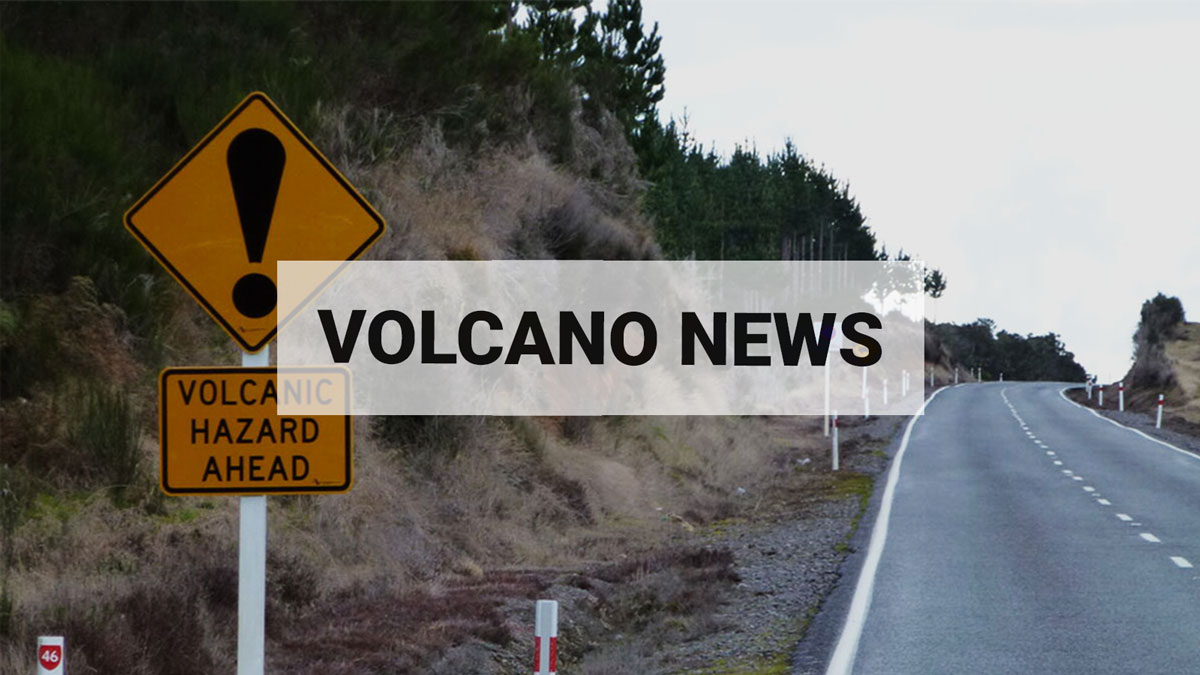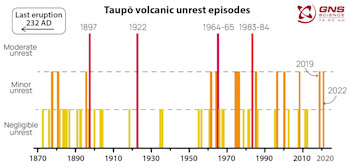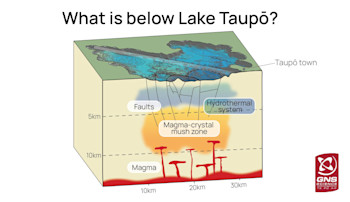National Advisory: Tsunami activity – expect strong and unusual currents and unpredictable surges at the shore following the M8.8 earthquake, Kamchatka Russia. For all information please visit NEMA (The National Emergency Management Agency) Only messages issued by NEMA represent the official warning status for New Zealand.

Some Frequently Asked Questions around the recent change in Volcanic Alert Level at Taupō volcano
The Volcanic Alert Level for Taupō volcano was increased to Level 1 on 20 September 2022. This was based on ongoing earthquakes and deformation at levels above typical background since May. These changes indicate minor volcanic unrest at Taupō volcano. Here we address some of the frequently asked questions around this change.
What does Volcanic Alert Level 1 mean?
In New Zealand, we use a system of Volcanic Alert Levels to define the current status of each active volcano. There are two levels assigned to volcanic unrest; Minor and Moderate to heightened unrest. Volcanic Alert Level 1 is the lowest level of unrest – Minor Unrest. Watch a video explaining: What are Volcanic Alert Levels in NZ.
Does this mean that Taupō volcano is going to erupt?
The chance of eruption at Taupō in any one year remains very low, and unrest would likely intensify a lot first. Caldera volcanoes such as Taupō often undergo unrest that lasts from days to years, without leading to eruption. Taupō has had 17 episodes of unrest in the past 150 years, and none of them led to an eruption. Unrest episodes at Taupō have lasted from a few days to 3 years, the average duration is around 5 months.
Why bother raising the Volcanic Alert Level now?
Taupō volcano has previously been at Volcanic Alert Level 0 – no volcanic unrest. Because of the increased level of seismic activity and deformation at Taupō volcano since May, the GNS Science Volcano Monitoring Group concluded that the current level of activity is better reflected by Volcanic Alert Level 1. This decision is informed by the level of current activity we can see using our monitoring observations, as well as our increased knowledge of Taupō volcano, and past unrest episodes coupled with evolving data processing techniques.
Watch a video explaining the current volcanic activity at Taupō
What does ‘volcanic unrest’ mean?
‘Volcanic unrest’ is when magma or magma-heated hot water and steam moves through the ground at depth beneath a volcano. This activity can produce earthquakes, ground movement and changes in hydrothermal systems. Feeling small-moderate earthquakes will be the most common experience for people near the volcano.
What is causing all the earthquakes under the lake?
We think the earthquakes are being caused by magma movement deep in the volcano. The magma and surrounding hydrothermal fluids are creating stress in the rocks around and/or above the magma chamber, causing them to break, which we can see as earthquakes. We have now located over 750 earthquakes, mainly at a depth of 4 to 13 km beneath the lake since the unrest began in May 2022. The animation below shows the earthquakes located since May 2022:
I've seen lots of pumice on the lake recently, is this from the volcano?
All the cliffs around the lake are full pumice from Taupō volcanoes previous eruptions, as are the banks of the rivers flowing into the lake. Every significant weather event flushes a new batch of pumice into the lake, these form pumice rafts and eventually end up in a bay on the lake shore. A very common event on the lake.
Is Taupō ‘overdue’ for an eruption?
There have been 29 eruptions in the last 25,500 years, 25 of those in the last 12,000 years - and the last eruption was 1800 years ago in 232 ±10 AD. These eruptions have not occurred at a regular interval, so you cannot say that Taupō is ‘overdue’ for an eruption.
If it did erupt, how big would it be?
You may have heard of Taupō’s last eruption, which occurred around 232 AD, as it was exceptionally large. However, most of the 29 eruptions at the volcano in the past 25,500 years have been much smaller. They are typically around or larger than the eruption at Ruapehu in 1995-1996, and smaller than the Tarawera 1886 eruption. Eruptions even smaller than this may have also occurred, but evidence is not preserved.
For a very large eruption to occur, we would expect to see significant unrest for many years as the magma accumulates beneath the volcano. We have not seen this to date. This means that the chance of a very large eruption occurring straight from minor unrest is extremely low.
Is there a tsunami risk from the volcano?
Although rare, tsunamis can happen at Lake Taupō or other lakes in New Zealand, however, they not expected to occur due to minor unrest at the volcano.
Tsunami-type waves in lakes can be caused by earthquakes, landslides, or even weather conditions, they are commonly called seiches. We know these have occurred in the past at Lake Taupō from historic records. If you are by the lake shore and feel a long or strong earthquake, drop, cover and hold and then immediately move to higher ground. Landslides could be triggered by larger earthquakes if they occurred in this sequence.
In the extremely unlikely event this sequence progressed to an eruption, in coming months or years, eruption processes could cause tsunami. Although large tsunami are only expected to be linked to moderate and large, extremely unlikely, eruptions. If you do notice lake water acting unusually, move away and to higher ground.
How do you know what is happening underneath the lake?
Unfortunately, we cannot see with our eyes what is happening under Lake Taupō. So, we can use our monitoring equipment around the edges and on Horomātangi Reef and interpret the data to get a good idea of what is going on. We use seismometers to locate earthquakes, and GNSS (GPS) data to look at how the ground is moving. Research has shown there is likely to be a crystal rich magma body at about 5-15km km deep beneath the Lake.
We can also look at rocks erupted in the past to understand what the magma body might be doing in the long term. The challenge is trying to identify from seismic and deformation signals if there are areas of magma that have separated from the crystal rich zones, areas that might be available to erupt. The number of eruptions and the volumes involved over the last 25,500 years indicate a significant source of magma is needed to supply the volcano.
Is there a hydrothermal system under Lake Taupō?
Yes, geophysical and chemical surveys of the lake have established that there is a hydrothermal system at depth under some of the lake. This is centred around the Horomātangi Reef area and extends NW for 3-5 kilometers towards the Western Bay area. There are three areas of gas vents south of the Horomātangi Reef on the lake floor. Changes in the system if unrest developed further may involve increases in heat flow, with larger fluid and gas emissions.
Are all the volcanoes in the North Island linked?
Taupō Volcano is one of many active volcanoes in the Taupō Volcanic Zone, which stretches from Ruapehu in the south to Whakaari / White Island in the north. This is a tectonically very active region with many known faults, active volcanism and geothermal systems. Activity in this region is often related to a mix of regional deformation processes and the magmatic system under the volcanoes. So, while they are linked by their position on the same tectonic plate, they have individual magma systems fuelling their eruptions. This means they behave as individuals.
How do I prepare for a volcanic eruption?
At this stage the most likely hazards are to do with unrest, not eruptions. There is ongoing earthquake activity at the moment, so we can expect more to continue for now. If there is earthquake shaking, drop, cover and hold.
There can be many hazards associated with an eruption, you can read more about volcanic hazards here and volcanic ash here.
The Tūwharetoa Māori Trust Board (CEO Rakeipoho Taiaroa) is closely involved in discussions with GNS Science as the landowner of Lake Taupō. More information about the Trust can be found at: https://www.tuwharetoa.co.nz/
During volcanic activity, follow official advice provided by your local Civil Defence Emergency Management Group. See Taupō District here
The National Emergency Management Agency (NEMA) has a great website with information on what to do before, during and after volcanic activity.
Prepare your home. Protect your whānau.
There’s a lot we can do to make our homes safer and stronger for earthquakes. Toka Tū Ake EQC’s website has key steps to get you started.
Media contact: 021 574 541 or media@gns.cri.nz




